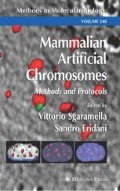Abstract
An artificial chromosome is a synthetic structure that carries three fundamental components for its long-term survival, replication, and segregation after cell division. These components are telomeres, one or more replication origins, and a centromere. The creation of such a molecule became feasible initially in the budding yeast Saccharomyces cerevisiae, where replication origins and centromeric sequences are well defined. In this organism, autonomously replicating sequences (ARS) were isolated by their ability to allow replication of plasmids carrying them. Plasmids containing an ARS element are capable of extrachromosomal replication in selective conditions but are lost if selection is removed from the culture because of unequal segregation. Introduction of a functional centromere to an ARS plasmid provides mitotic stability to the resulting yeast artificial chromosome (YAC) (reviewed by Newlon in ref. 1).
Access this chapter
Tax calculation will be finalised at checkout
Purchases are for personal use only
References
Newlon, C. S. (1988) Yeast chromosome replication and segregation. FEMS Microbiol. Rev. 52, 568–601.
Farr, C.J., Stevanovic, M., Thomson, E. J., Goodfellow, P. N., and Cooke, H. J. (1992) Telomere-associated chromosome fragmentation: application in genome manipulation and analysis. Nat. Genet. 2, 275–282.
Auriche, C., Donini, P., and Ascenzioni F. (2001) Molecular and cytological analysis of a 5.5 Mb minichromosome. EMBO Rep. Feb. 2, 102–107.
Heller, R., Brown, K. E., Burgtorf C., and Brown W. R. (1996) Mini-chromosomes derived from the human Y chromosome by telomere directed chromosome breakage. Proc. Natl. Acad. Sci. USA 93, 7125–7130.
Shen, M. H., Mee, P. J., Nichols, J., Yang, J., Brook, F., Gardner, R. L., et al. (2000) A structural defined mini-chromosome vector for the mouse germline. Curr. Biol. 10, 31–34.
Murphy, T. D. and Karpen G. H. (1995) Localization of centromere function in a Drosophila minichromosome. Cell 82, 599–609.
Patnaik, P. K., Axelrod, N., Van der Ploeg, L. H., and Cross, G. A. (1996) Artificial linear mini-chromosomes for Trypanosoma brucei. Nucleic Acids Res. 24, 668–675.
Harrington, J. J., Van Bokkelen, G., Mays, R.W., Gustashaw, K., and Willard, H. F. (1997) Formation of de novo centromeres and construction of first-generation human artificial microchromosomes. Nat. Genet. 15, 345–355.
Ikeno M., Grimes, B., Okazaki, T., Nakano, M., Saitoh, K., Hoshino, H., et al. (1998) Construction of YAC-based mammalian artificial chromosomes. Nat. Biotechnol. 16, 431–439.
Henning K.A., Novotny E. A., Compton S. T., Guan X. Y., Liu P. P., and Ashlock M. A. (1999) Human artificial chromosomes generated by modification of a yeast artificial chromosome containing both human α-satellite and single-copy DNA sequences. Proc. Natl. Acad. Sci. USA 96, 592–597.
Ebersole T. A., Ross A., Clark E., McGill, N., Schindelhauer D., Cooke, H., et al. (2000) Mammalian artificial chromosome formation from circular alphoid input DNA does not require telomere repeats. Hum. Mol. Genet. 9, 1623–1631.
Ten Hagen, K. G., Gilbert, D. M., Willard, H. F., and Cohen, S. N. (1990) Replication timing of DNA sequences asociated with human centromeres and telomeres. Mol. Cell. Biol. 10, 6348–6355.
Frengen, E., Zhao, B., Howe, S., Weichenhan D., Osoegawa, K., Gjernes, E., et al. (2000) Modular bacterial artificial chromosome vectors for transfer of large inserts into mammalian cells. Genomics 68, 118–126.
Author information
Authors and Affiliations
Editor information
Editors and Affiliations
Rights and permissions
Copyright information
© 2004 Humana Press Inc.
About this protocol
Cite this protocol
de las Heras, J.I., D’Aiuto, L., Cooke, H. (2004). Mammalian Artificial Chromosome Formation in Human Cells After Lipofection of a PAC Precursor. In: Sgaramella, V., Eridani, S. (eds) Mammalian Artificial Chromosomes. Methods in Molecular Biology, vol 240. Humana Press. https://doi.org/10.1385/1-59259-434-4:187
Download citation
DOI: https://doi.org/10.1385/1-59259-434-4:187
Publisher Name: Humana Press
Print ISBN: 978-1-58829-096-0
Online ISBN: 978-1-59259-434-4
eBook Packages: Springer Protocols

